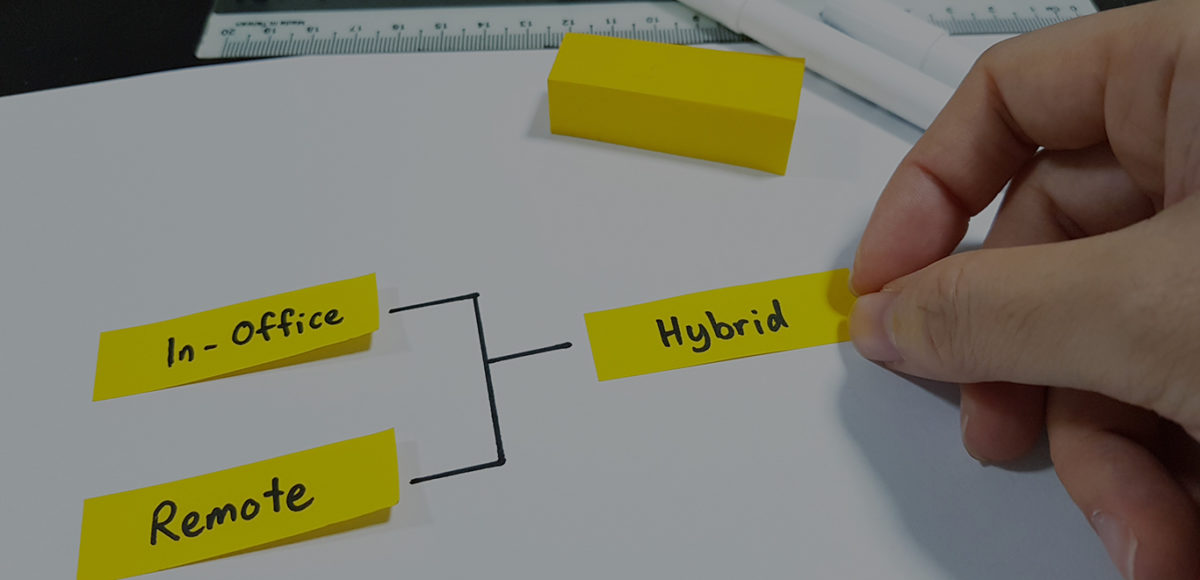As businesses began formulating their post-pandemic plans to return to the office, one strategy emerged as a leader: hybrid work. From December 2020 through January 2021, McKinsey surveyed 100 executives and found that 90% planned to embrace a hybrid model.
As we’ve all learned, this mix of on-site and remote work offers the flexibility that employees demand while addressing the need to maintain a physical workspace for various functions. In theory, it blends the best of all worlds to satisfy everyone with a mix of autonomy, flexibility, and focus. However, implementing the strategy has proven to be more challenging than many organizations anticipated.
Recent data from Tiny Pulse’s global employee engagement study suggested that the arrangement is proving to be more draining and difficult than full-time, in-office work, according to more than 80% of the human resources (HR) executives surveyed. That’s not to say that organizations should scrap their hybrid work schedules altogether.
Implementing an effective, hybrid workforce that improves employee well-being is a nuanced process that comes with unique challenges and benefits. It also requires frequent assessments to see what’s working and what doesn’t, along with changes to work habits and daily schedules.
Successful integration of a hybrid work model looks different for every organization, but one thing remains the same across all businesses. Coordinating effective hybrid work is possible with the right tools and strategies. Four steps, along with constant assessment and reassessment can help get you started assessing the functionality of hybrid work in your workplace.
Identify the Goals and Needs of the Organization, Teams, and Individuals
Effective hybrid work structures benefit individuals and organizations alike. The echoes of the Great Resignation’s effects and the lingering consequences of quiet quitting underscore the need to meet employees’ needs while also supporting the goals of the company at large. To make hybrid schedules work well for everyone involved, it’s critical to identify what those needs and goals are.
Understanding how, why, and when employees use the physical workspace. For example, innovation, brainstorming, and collaboration are typically best in person. Some roles may require more time spent in the office than others. Installing workplace sensors can help determine how the current space gets used. 4SITE by CORT empowers leaders with objective data while maintaining privacy, making it possible to make data-driven decisions about the evolving use of the office without compromising security.
Getting feedback from managers, team leaders, and employees is also helpful. It’s essential to understand what people want and how they work best. Some employees may focus best when working at home and only require time in the office for collaboration. Others may need to come into the office for focused work.
Maximizing the employee experience is a vital component of creating a hybrid strategy that works in the long term. Allowing individuals to have a say in how things are structured, encourages autonomy, which boosts engagement, productivity, and retention.
Scheduling Considerations
As leaders gain details about individual and team needs and how in-person and remote work schedules play into the organization’s goals, they can also glean insight into the type of hybrid work schedule that will work best. Common types of hybrid schedules include:
- Employee-choice schedules allow employees to choose the days they come to the office without a set schedule. This provides maximum flexibility but restricts leaders’ ability to plan.
- Team-specific schedules assign teams and individuals days to come to the office based on their function. For example, the marketing and sales teams might both come to the office on Wednesdays for collaboration. Although there are varying numbers of employees in the office on any given day, there’s a set schedule, making it easy for leaders to plan accordingly.
- Manager-assigned schedules assign individuals specific days to come into the office for focused work, team projects, meetings, and work sessions. Like team-specific schedules, it allows for ample planning.
- Mixed schedules combine all three scheduling strategies for a mix-and-match approach that delivers flexibility and the ability to plan.
Asking questions about how employees work best and getting their opinions is only the beginning. When deciding on a hybrid schedule, organizations must also ask questions like:
- Will this support the company’s goals and business objectives as well as employees’ preferences?
- What departments, teams, or individuals need to be on-site simultaneously?
- How difficult will it be to manage this schedule and plan ahead to ensure ample resources are available?
- Do we have the right tools on hand to implement this hybrid schedule effectively?
Once leaders decide on a hybrid schedule, having an app-agnostic tool like 4SITE can help manage the continual need for assessment. In addition to allowing decision-makers to evaluate how spaces are used, it works with any booking or reservation system for seamless, secure operation.
Create a Flexible In-office Work Environment
The schedule is only one piece of the equation. The design of the physical workspace must meet the needs of in-office work demands and goals. According to research from Gallup that asked how hybrid workers spent most of their time working in the physical office, the top responses included meeting with colleagues or managers, engaging in collaborative activities, and using technology they can’t access anywhere else.
Once there’s a clear direction about how the spaces will be used, they must then be tailored to the office’s specific needs while allowing some flexibility for changes in the future. Many organizations include space for quiet, focused work in addition to meeting spaces, private areas, and lounge spaces for brainstorming and collaboration.
CORT Permanently Flexible® Solutions is made of two tools to help businesses using four key steps: Experiment, Measure, Modify, and Repeat. 4SITE technology handles the measurement, while CORT Furniture-as-a-Service™ (FaaS) is the magic that brings it all together. The benefits of having access over ownership allow every workspace to remain dynamic. FaaS allows leaders to change rooms or the entire footprint quickly based on evolving needs. For example, if a business wants to transform a private office into a lounge space for collaboration, they can add soft seating like the Nielson loveseat and Anson accent chairs. And when they want to transform the space into a conference room, CORT will pick up the soft seating to replace it with tables, such as the Godenza or Bainbridge, and task chairs.
Ultimately, FaaS encourages agility and allows businesses to experiment and modify their plans in response to shifting needs with the least amount of friction.
Prioritize Inclusivity in Hybrid Work Planning
Another vital element of effective hybrid practices is inclusion. Past approaches to offering increased flexibility in many workplaces led to teams and individuals questioning the fairness of who was chosen to take advantage of that. Some employees may have had job functions that made remote work untenable. In the end, when employees feel that there’s a lack of inclusion and fairness in the workplace, it can increase burnout, reduce engagement, and decrease productivity.
Designing an inclusive workplace is critical. Organizations that include their employees in hybrid work planning are better positioned to make sure everyone feels valued, respected, and accepted while empowering them and connecting them deeply to the company culture.
Some ways to ensure a hybrid work plan is inclusive include inviting employees across various departments, job titles, and locations to provide feedback or participate in the design process. Tools like surveys and town hall-like meetings encouraging open dialogue about hybrid work preferences can help everyone better understand the impact hybrid work may have on their schedules and productivity.
Creating Effective Hybrid Work Schedules
Hybrid work isn’t working for everyone. Research shows that eight out of 10 employees are facing more exhaustion and burnout than when they worked fully remotely or full-time in the office. Despite those discouraging figures, hybrid work schedules can benefit everyone involved, employees and organizations alike.
But it takes work, starting with identifying the needs, wants, and goals of the employees and the business. Choosing the right type of hybrid work schedule, designing a flexible office that meets the workforce’s needs, and adopting inclusivity are essential elements that increase employee engagement and productivity.
With tools like 4SITE by CORT and CORT FaaS, every workplace can become Permanently Flexible and better able to pivot quickly to meet changing needs and demands. Learn more about how CORT can support your business today to begin creating the effective hybrid work schedules and physical office space your workforce needs.






